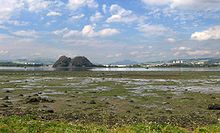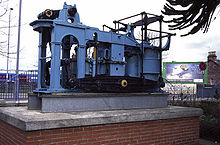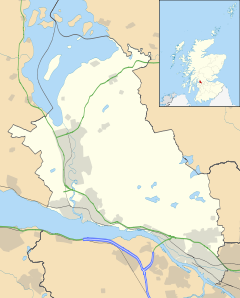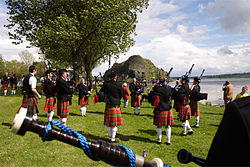- Dumbarton
-
For other uses, see Dumbarton (disambiguation).
Coordinates: 55°57′00″N 4°34′00″W / 55.95°N 4.566667°W
Dumbarton Scottish Gaelic: Dùn Breatainn[1] Scots: Dumbartoun or Dumbertan[2]
 Dumbarton shown within West Dunbartonshire
Dumbarton shown within West DunbartonshirePopulation 20,527 [3] (2001 census)
est. 19,990[4] (2006)OS grid reference NS397759 - Edinburgh 54 mi (87 km) E - London 356 mi (574 km) SSE Council area West Dunbartonshire Lieutenancy area Dunbartonshire Country Scotland Sovereign state United Kingdom Post town DUMBARTON Postcode district G82 Dialling code 01389 Police Strathclyde Fire Strathclyde Ambulance Scottish EU Parliament Scotland UK Parliament West Dunbartonshire Scottish Parliament Dumbarton List of places: UK • Scotland • Dumbarton (from Scottish Gaelic: Dùn Breatainn meaning "fort of the Britons",[5] pronounced [t̪umˈpɾʲɛʰt̪ɪɲ]) is a town and burgh which is the administrative centre of the council area of West Dunbartonshire, and formerly of the historic county of Dunbartonshire, in the West-Central Lowlands of Scotland. The town lies on the north bank of the River Clyde where the River Leven flows into the Clyde estuary. As of 2006, the town had an estimated population of 19,990 and forms a conurbation with Alexandria, Bonhill and Renton with a combined estimated population of 44,690.[4]
Dumbarton functioned as the capital of the ancient Kingdom of Strathclyde, and later as the county town of the county of Dunbartonshire.[6] Dumbarton Castle, sitting on top of Dumbarton Rock, dominates the area. Dumbarton was a Royal burgh between 1222 and 1975.[7]
Dumbarton emerged from the 19th century as a centre for shipbuilding, glassmaking, and whisky production. However these industries have since declined, or demised altogether, and Dumbarton today increasingly functions as a commuter town for the major City of Glasgow which is 13 miles (21 km) east-southeast. Dumbarton F.C. is the burgh's local association football club.[6]
Dumbarton is home to the BBC Scotland's drama studios, notable for filming River City, Hope Springs and Personal Affairs.
Contents
History
Dumbarton history goes back at least as far as the Iron Age and probably much earlier. It was the site of a strategically important early settlement, the residents of which were known to have traded with the Romans.[6] The earliest record of a settlement in Dumbarton is a record in Irish chronicles of the death of Guret, rex Alo Cluathe ("king of Clyde Rock"), in AD 658;[8] but a story about another king of Clyde Rock (petra Cloithe) in Adomnan's Life of St Columba (book 1, chapter 15) probably predates this, and a later source links King Ceretic, a British King who received a letter from St Patrick with Ail, thought to be Clyde Rock.[citation needed]
Dumbarton functioned as the royal centre of the kingdom of Clyde Rock mentioned in these sources, but had probably been eclipsed as a "capital" by the time of the establishment of the ancient Kingdom of Strathclyde around 900. It was later the county town of the county of Dunbartonshire, formerly known as Dumbartonshire. The name comes from the Scottish Gaelic Dùn Breatainn meaning "fort of the Brythons (Britons)", and serves as a reminder that the earliest historical inhabitants of Clydesdale spoke an early form of the Welsh language. These Britons themselves knew this dùn as Alt Clut, "Clyde Rock", a name which occurs both in Gaelic and in English sources of the 7th, 8th and 9th centuries (also spelled Alclud, Alcluyd, Alcluith).
Dumbarton was struck severely by the black death in 1350 and much of it burned down in 1424. But by the 17th century it was an important port with trade routes going as far afield as the West Indies. By 1800 the town was Scotland's largest producer of glass, for bottles and windows.[6]
In September 1605 Chancellor Dunfermline reported to King James VI that inundations of the sea were likely to destroy and take away the whole town. It was estimated that the flood defences would cost 30,000 pounds Scots, the cost being levied nationwide.[9]
During World War II Dumbarton was heavily bombed by the German air force. The Germans were targeting the shipyards, and the area in the vicinity of the yards was consequently hit, with Clyde and Leven Street being severely damaged. In an attempt to lure the German aircraft away from the shipyards, decoy lights were routinely placed on the Kilpatrick hills above the town, lights were set out on reservoirs to mimic those of the shipyards reflecting on the waters of the Leven and Clyde. The ploy was sometimes successful in diverting the bombers and many bombs fell harmlessly onto the moors and lochs.
Castle
Main article: Dumbarton CastleDumbarton Castle sits on Dumbarton Rock, at the east bank mouth of the River Leven, where it flows into the Clyde estuary.
The Castle has an illustrious history and many well-known figures from Scottish and British history have visited it. The castle was a royal fortress long before Dumbarton became a Royal Burgh, its ownership went from Scottish to English and back again. The castle was an important place during the Wars of Independence and was used to imprison William Wallace for a short time after his capture by the English. It was from here that Mary, Queen of Scots, was conveyed to France for safety as a child. Mary was trying to reach Dumbarton Castle when she suffered her final defeat at Langside. In later times, Queen Victoria and Queen Elizabeth II visited the castle.[6]
Today, Dumbarton Rock is a Scheduled Ancient Monument, it has legal protection in order to maintain and conserve the site for the future. As such any sort of work on the rock is strictly regulated by the Scottish Government and activities such as climbing on the rock are forbidden. From the top of the castle can be seen both the River Clyde and Leven Grove Park.
Levengrove Park
Levengrove Park itself was a gift to the town by the Dennys who owned the shipbuilding company which was about 100 yards (100 m) away from the Castle. This was said to be not a purely philanthropic act however; the American company Singer which is famous for the manufacturing of sewing machines had earmarked the land as a potential site for their factory which would eventually be built in Clydebank. Denny were in effect protecting their monopoly on the local work-force.
Governance
 A northwards view of Dumbarton across the tidal River Clyde, with the distant Ben Lomond visible to the right of Dumbarton Rock
A northwards view of Dumbarton across the tidal River Clyde, with the distant Ben Lomond visible to the right of Dumbarton Rock
From 1975 Dumbarton lent its name to a local government district in the Strathclyde region of Scotland. In 1996 the administrative functions of this district transferred to the West Dunbartonshire and Argyll and Bute unitary councils (see Subdivisions of Scotland).
Dumbarton town currently serves as the administrative centre of the West Dunbartonshire authority.
There is a Dumbarton constituency of the Scottish Parliament and a former Dumbarton constituency of the House of Commons.
Education
There are two secondary schools, namely Dumbarton Academy and Our Lady & St Patrick's High School. There are also seven primary schools: St. Michael's Primary, Knoxland Primary, Braehead Primary, St. Peter's Primary, St. Patrick's Primary, Aitkenbar Primary and Dalreoch Primary.
Geography
Civic Coat of Arms for Dumbarton
There are a number of distinct areas of the town:
- Bellsmyre
- Brucehill
- Castlehill
- Dennystown
- Dumbarton East incl. Newtown
- Oxhill
- Kirktonhill
- Silverton
- Townend
- Westcliff
Economy
Shipbuilding
From the mid 18th century to the early 19th century Dumbarton's main industry was glassmaking. As the glass industry declined the town became a major centre for shipbuilding and remained so well into the 20th century. There were many shipbuilding yards, although a number of them were later absorbed by larger yards. A great many ships were built in the town, the most famous of which is probably the Cutty Sark which was built by Scott & Linton, she was one of the final Tea Clippers to be built, and one of the fastest. The ship is the last survivor of its type and can be seen today at dry dock in Greenwich, London. In 1818 William Denny built the Rob Roy named after Robert Roy MacGregor in Dumbarton, which went on to become the first steam powered ferry crossing the English Channel.
William Denny and Brothers
 Early side-lever engine designed by Robert Napier, from PS Leven (1823), on display at the Scottish Maritime Museum
Early side-lever engine designed by Robert Napier, from PS Leven (1823), on display at the Scottish Maritime Museum
The last major Dumbarton shipyard was William Denny and Brothers which closed in 1963, and the remaining smaller yards followed over the next few decades. The old Denny's shipyard tender The Second Snark is still in use on the Firth of Clyde as a passenger ferry and cruise boat. Denny's was an innovative company that had a reputation for research and development; high pressure turbines and hull stabilisation were two areas where they were highly respected. They even built an early design of helicopter in 1909 and in their final years they were involved in hovercraft development in the form of the Denny D2 Hoverbus. A film clip of this vessel on its maiden trip to Oban exists in the Scottish Film Archive.
The last surviving part of the Denny's shipbuilding company is the Denny Ship Model Experiment Tank which forms part of the Scottish Maritime Museum. This was the first commercial ship model testing tank built in the world and it retains many original features today: a water tank as long as a football pitch, clay moulding beds for casting wax model ship hulls and the original Victorian machinery used for shaping models.
During the Second World War Blackburn Aircraft were to produce Sunderland flying boats from a factory adjacent to Denny's shipyard.
There is still a shipyard on the river Leven, Sandpoint Marina.[10]
The 'Denny Club' was a local social club was named after Denny's shipyard. The club closed down a number of years ago after running into financial difficulties. The club was the sponsor of a local amateur football team, Dumbarton Amateurs, which subsequently changed its name to Denny Amateurs due to the continuning sponsorhip and support from the club. Denny Amateurs still play today, and has recently developed a team for younger players in the area, 'Denny Youth', and has provided the new team with strips and equipment along with advice and support.
Whisky
As the ship industry declined, whisky production grew to become the dominant industry in the town. In 1938 Hiram Walker's built a large whisky distillery on the river Leven (on the site of some of the old shipyards), the town became known as a major centre of the whisky industry in the mid to late 20th century. Hiram Walker was acquired by Allied brewers in 1988 to form Allied Distillers, itself becoming part of Allied Domeq before eventually being taken over in 2005 by the French based alcohol giant Pernod Ricard. The large Dumbarton distillery had been mothballed since 2002 and not long after the Pernod-Ricard takeover the giant red buildings of the Dumbarton 'Ballantine's' distillery which had dominated the town for over sixty years were earmarked for demolition and redevelopment (as of July 2008 only the tower remains standing). However the large bonded warehouse complex to the east of the town and the bottling complex to the north west were retained.
Other whisky related site closures such as the Inverleven distillery which closed in 1991 and the J&B Scotch Whisky bottling plant and bond in the north of the town have contributed to the decline in Dumbarton's importance to the drink industry. However part of the J&B bond has found a new life as a film set for television productions such as 'River City' and 'Still Game'.
Ballantine's Whisky became well known for the rather unusual 'security' guards used at their bonded warehouse complex at Dumbuck in Dumbarton; these are a large flock of white Chinese geese that were first introduced in 1959. Starting with just six individuals, this has risen to close to 100 birds today. They have the nickname 'The Scotch Watch' and have been widely used in promotional material for the Ballantine's blended whisky. But today they have been replaced by CCTV cameras.
Other industries
With the decline of the whisky industry, Dumbarton is becoming more a commuter town for those who work in nearby Glasgow and other locations. The Faslane naval base is a major employer for the area. The Strathleven Industrial Estate near Dumbarton was once the location of several major manufacturers such as Burroughs (Adding Machines) and Westclox. Technology overtook these companies and they closed down with the loss of many jobs. The estate has also been the home of Polaroid UK since 1965. This was the largest Polaroid plant outside of the USA and at its peak it employed about 1800 people. Failing to recognise the impact of digital photography was its downfall and while they still have a presence in Dumbarton less than 100 people are now employed there (mainly in the manufacture of sunglass lenses). The generator supplier Aggreko plc have some major operations based in the town.
Culture
Sports
There was at one stage two Scottish Football League clubs from the town, Dumbarton Harp F.C. which no longer exists and still around is professional football team Dumbarton F.C. Also known as 'Sons of the rock', it is an old club founded in 1872 and steeped in history. The club play home games at the Strathclyde Homes Stadium, next to Dumbarton Castle. They won the Scottish Cup in 1882/3 and five times were beaten finalists. As reigning Scottish Cup holders, they met the FA Cup winners, Blackburn Olympic, and thrashed them 6-1 to be hailed as champions of Great Britain. As there were no other formal leagues at this time, Dumbarton were also proclaimed Champions of the World. The Scottish League was formed in 1890 and the very first championship was shared between Dumbarton and Rangers. Dumbarton play in gold and black strips.
There are seven bowling clubs in Dumbarton: Brock Bowling Club, Dixon BC, Dumbarton BC, Dumbuck BC, Eastfield BC, Rock BC and Townend BC.
Dumbarton is home to the basketball team Dumbarton Dodgers Basketball Club who play in the Strathclyde basketball league. The team formed in 1981 from a youth club in Riverside Parish Church in the town.
The town is the birthplace of the motor-racing driver Sir Jackie Stewart OBE. He competed in Formula One between 1965 and 1973, winning three World Drivers' Championships. The Stewart Family owned and ran the garage at Dumbuck in Milton to the East of the town, the Garage later being taken over by Jackie's close friend John Lindsay.[11]
Arts
Scottish poet Robert Burns was made freeman of Dumbarton. He refers to Dumbarton in a letter written in 7 July 1787.
- "... I have lately been rambling over by Dumbarton and Inverary, and running a drunken race on the side of Loch Lomond with a wild Highlandman; his horse, which had never known the ornaments of iron or leather, zigzagged across before my old spavin’d hunter, whose name is Jenny Geddes, and down came the Highlandman, horse and all, and down came Jenny and my bardship; so I have got such a skinful of bruises and wounds, that I shall be at least four weeks before I dare venture on my journey to Edinburgh."
Dumbarton is also immortalised in the traditional Scottish song "Dumbarton's Drums".[12]
- Across the fields of bounding heather,
- Dumbarton sounds the hour of pleasure;
- The joy I know will know no measure,
- When Johnnie kneels and kisses me. (one verse)
Novelist A. J. Cronin's maternal grandfather, Archibald Montgomerie, owned a hat shop at 145 High Street.
Dumbarton is the birthplace of David Byrne, a Grammy Award, Academy Award and Golden Globe-winning musician best known as the founding member and principal songwriter of New Wave band Talking Heads.
Glaswegian band Franz Ferdinand released a remix of their hit song, "Take Me Out" called "David Byrne Was Born in Dumbarton" which heavily sampled the Talking Heads song, "Burning Down the House".
Royal Scottish Pipe Bands Championships
Held in Dumbarton since 2000, the Royal Scottish Pipe Band Championships sees over 140 bands enter yearly, including representatives from Sweden, Denmark, Netherlands and Ireland. The championships is one of the biggest and most prestigious pipe band events in the world. Besides the pipe band championships there is a fun fair and Highland dancing competitions.
Theatre
The Denny Civic Theatre is used by a number of local groups, including the Dumbarton People's Theatre.
Travel connections
Dumbarton is 10 minutes away from Balloch where cruises can be taken to explore Loch Lomond. Glasgow city centre is approximately 30 minutes away by train. With three railway stations and four services every hour, this makes easy commuting.
Overtoun House
Overtoun House is a mansion in the Scots Baronial style built on an estate in the hills overlooking the town between 1859-1862 for a wealthy chemical manufacturer originally from Glasgow, James White.[13] The house is reputed to be haunted. In 2005 the Overtoun estate gained some notoriety as it was uncovered by a local journalist that around fifty dogs had mysteriously jumped from the Overtoun Bridge over Overtoun burn over the years, the topic caught the public imagination and became the subject of a channel five documentary in late 2006.[14]
See also
References
- ^ Ainmean-Àite na h-Alba ~ Gaelic Place-Names of Scotland
- ^ Scots Language Centre: Scottish Place Names in Scots
- ^ "Comparative Population Profile: Dumbarton Locality". Scotland's Census Results Online. 2001-04-29. http://www.scrol.gov.uk/scrol/browser/profile.jsp?profile=Population&mainArea=dumbarton&mainLevel=Locality. Retrieved 2008-09-02.
- ^ a b "Publications and Data". General Record Office for Scotland. http://www.gro-scotland.gov.uk/statistics/publications-and-data.
- ^ "Visions of Britain". http://www.visionofbritain.org.uk/descriptions/entry_page.jsp;jsessionid=4D6D4999541B97B99E16F7023A499772?text_id=106330&word=NULL.
- ^ a b c d e "Dumbarton". http://www.undiscoveredscotland.co.uk/dumbarton/dumbarton/index.html.
- ^ "Vision of Britain". http://www.visionofbritain.org.uk/relationships.jsp;jsessionid=B3C4D5066274081631BABB0D710A831C?u_id=10359089. Retrieved 2008-03-04.
- ^ "Annals of Ulster". http://www.ucc.ie/celt/published/G100001A/index.html.
- ^ Chambers, Robert (1885). Domestic Annals of Scotland. Edinburgh : Chambers. p. 183.
- ^ "Sandpoint Marina". http://www.sandpoint-marina.co.uk/.
- ^ "Stewart set for Freedom of Dumbarton". http://www.lennoxherald.co.uk/lifestyle/latest-lifestyle/2009/01/23/jackie-stewart-set-for-freedom-of-dumbarton-114557-22739582/Jackie.
- ^ "Dumbarton's Drums". Traditional Scottish Songs - Dumbarton's Drums. rampantscotland.com. http://www.rampantscotland.com/songs/blsongs_dumbarton.htm. Retrieved 3 October 2010.
- ^ Overtoun House accessed 18/03/08
- ^ Daily Mail Why have so many dogs leapt to their deaths from Overtoun Bridge? accessed 18/03/08
External links
- Robert Burns (poet) Links to Dumbarton
- Scottish Maritime Museum
- Dumbarton Football Club
- Brock Bowling Club (Dumbarton)
- UK Rock Climbing (Dumbarton)
Hen Ogledd Major kingdoms Minor kingdoms and subregions Aeron • Calchfynydd • Eidyn • Manaw Gododdin • NovantOther places People Aneirin • Clydno Eiddin • Coel Hen • Cunedda • Saint Kentigern • Elffin ap Gwyddno • Gwallog ap Llaennog • Gwenddolau • Llywarch Hen • Morcant Bulc • Myrddin Wyllt • Owain mab Urien • Pabo • Rhydderch Hael • Talhaearn • Taliesin • Urien • Gwrgi and PeredurCategories:- Dumbarton
- Large burghs
- Scottish county towns
- Shipbuilding / shipbreaking localities of Scotland
- Towns in West Dunbartonshire
- Clyde-built ships
Wikimedia Foundation. 2010.





